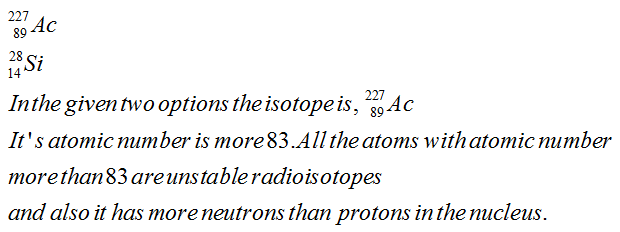227 28 (b) Ac Si 14 89 227 89 Ac 14 Si Explain your choice. Its atomic number is greater than 83. Its atomic number is less than 83. It has more neutrons than protons in the nucleus. It has fewer neutrons than protons in the nucleus. It is an even-even nuclide. O It is an odd-odd nuclide. O none of these
227 28 (b) Ac Si 14 89 227 89 Ac 14 Si Explain your choice. Its atomic number is greater than 83. Its atomic number is less than 83. It has more neutrons than protons in the nucleus. It has fewer neutrons than protons in the nucleus. It is an even-even nuclide. O It is an odd-odd nuclide. O none of these
Chemistry
10th Edition
ISBN:9781305957404
Author:Steven S. Zumdahl, Susan A. Zumdahl, Donald J. DeCoste
Publisher:Steven S. Zumdahl, Susan A. Zumdahl, Donald J. DeCoste
Chapter1: Chemical Foundations
Section: Chapter Questions
Problem 1RQ: Define and explain the differences between the following terms. a. law and theory b. theory and...
Related questions
Question
Pick the radioactive isotope and reasoning for each set

Transcribed Image Text:The image consists of a multiple-choice question about the properties of isotopes.
**Question Part (b):**
Isotopes Presented:
- Option 1: \( \frac{227}{89} \text{Ac} \)
- Option 2: \( \frac{28}{14} \text{Si} \)
A radio button is selected for:
- \( \frac{28}{14} \text{Si} \)
**Explanation of Choice:**
Below the isotopes, there is a section titled "Explain your choice" with several options. The selected option is:
- "It has more neutrons than protons in the nucleus."
Other Options Provided:
- Its atomic number is greater than 83.
- Its atomic number is less than 83.
- It has fewer neutrons than protons in the nucleus.
- It is an even-even nuclide.
- It is an odd-odd nuclide.
- None of these.
A red cross mark appears next to both the selected isotope and the selected explanation option, indicating incorrect selections.

Transcribed Image Text:### Educational Example on Isotopes
#### Question:
Given the isotopes of phosphorus:
- \( \text{}_{15}^{29}\text{P} \)
- \( \text{}_{15}^{31}\text{P} \)
Select the correct isotope and explain your choice.
#### Options:
- \( \text{}_{15}^{29}\text{P} \)
- \( \text{}_{15}^{31}\text{P} \) (Correct)
#### Explanation of Choice:
**Explain your choice:**
- ○ Its atomic number is greater than 83.
- ○ Its atomic number is less than 83.
- ● It has more neutrons than protons in the nucleus. (Correct)
- ○ It has fewer neutrons than protons in the nucleus.
- ○ It is an even-even nuclide.
- ○ It is an odd-odd nuclide.
- ○ None of these.
In this exercise, the correct isotope selected is \( \text{}_{15}^{31}\text{P} \), which has more neutrons than protons. This is demonstrated by selecting it in the interface, receiving a checkmark for the correct selection, but then indicating an explanation error due to an incorrect choice selection reasoning below.
Expert Solution
Step 1

Step 2

Trending now
This is a popular solution!
Step by step
Solved in 3 steps with 3 images

Knowledge Booster
Learn more about
Need a deep-dive on the concept behind this application? Look no further. Learn more about this topic, chemistry and related others by exploring similar questions and additional content below.Recommended textbooks for you

Chemistry
Chemistry
ISBN:
9781305957404
Author:
Steven S. Zumdahl, Susan A. Zumdahl, Donald J. DeCoste
Publisher:
Cengage Learning

Chemistry
Chemistry
ISBN:
9781259911156
Author:
Raymond Chang Dr., Jason Overby Professor
Publisher:
McGraw-Hill Education

Principles of Instrumental Analysis
Chemistry
ISBN:
9781305577213
Author:
Douglas A. Skoog, F. James Holler, Stanley R. Crouch
Publisher:
Cengage Learning

Chemistry
Chemistry
ISBN:
9781305957404
Author:
Steven S. Zumdahl, Susan A. Zumdahl, Donald J. DeCoste
Publisher:
Cengage Learning

Chemistry
Chemistry
ISBN:
9781259911156
Author:
Raymond Chang Dr., Jason Overby Professor
Publisher:
McGraw-Hill Education

Principles of Instrumental Analysis
Chemistry
ISBN:
9781305577213
Author:
Douglas A. Skoog, F. James Holler, Stanley R. Crouch
Publisher:
Cengage Learning

Organic Chemistry
Chemistry
ISBN:
9780078021558
Author:
Janice Gorzynski Smith Dr.
Publisher:
McGraw-Hill Education

Chemistry: Principles and Reactions
Chemistry
ISBN:
9781305079373
Author:
William L. Masterton, Cecile N. Hurley
Publisher:
Cengage Learning

Elementary Principles of Chemical Processes, Bind…
Chemistry
ISBN:
9781118431221
Author:
Richard M. Felder, Ronald W. Rousseau, Lisa G. Bullard
Publisher:
WILEY